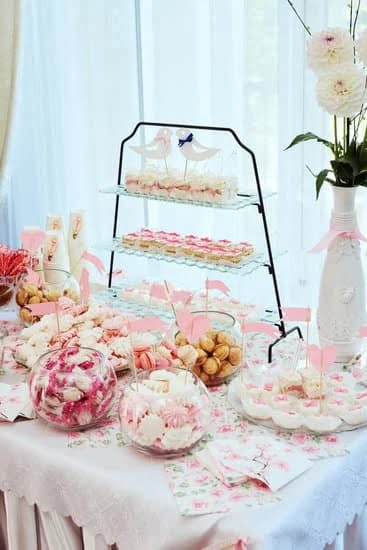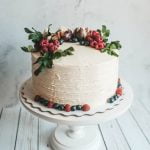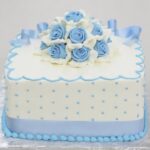Cake decorations play a crucial role in turning a simple dessert into a stunning masterpiece. From birthdays to weddings, the visual appeal of a cake can make or break a special occasion.
And when it comes to adding that extra touch of elegance and creativity, chocolate decorations are the perfect solution. In this article, we will explore the world of chocolate as an art medium for cake decorations, providing you with step-by-step instructions on how to make chocolate decorations on cake that will leave everyone in awe.
Chocolate has long been renowned for its rich and luxurious taste, but it also possesses the ability to elevate the aesthetic appeal of any dessert it adorns. Whether you’re a professional pastry chef or an avid home baker, mastering the art of creating chocolate decorations can take your cake designs to new heights. With just a few simple techniques and tools, you can transform plain cakes into exquisite works of edible art.
Understanding the basics is key when it comes to working with chocolate for decorations. Different types of chocolate have varying qualities that affect their suitability for certain designs. In the following sections, we’ll delve into the nuances of using various types of chocolates, as well as share tips on sourcing high-quality products for optimal results.
So if you’re ready to embark on a delicious journey through the world of chocolate decoration, let’s dive right in. From understanding the basics to exploring advanced techniques and troubleshooting common mistakes, this comprehensive guide will equip you with everything you need to know about making stunning chocolate decorations on cake. Get ready to impress your family and friends with your newfound skills and elevate your cake decorating game like never before.
Understanding the Basics
When it comes to making chocolate decorations on cakes, one of the most important aspects is choosing the right type of chocolate. Not all chocolates are created equal, and certain varieties work better than others for creating stunning designs. In this section, we will explore the different types of chocolate that are suitable for making decorations.
- Dark Chocolate: Dark chocolate, with its rich and intense flavor, is a favorite among many bakers for creating chocolate decorations. It has a higher percentage of cocoa solids and less sugar compared to other types of chocolate. This makes it more forgiving when it comes to melting and tempering. Dark chocolate is perfect for creating curls, shards, and intricate piped designs.
- Milk Chocolate: Milk chocolate has a milder flavor compared to dark chocolate, making it a popular choice for those who prefer a sweeter taste. Its creamy texture lends itself well to creating smooth and silky decorations. Milk chocolate can be used for molding shapes or piping delicate designs onto cakes.
- White Chocolate: Although some may argue that white chocolate isn’t technically “chocolate” because it doesn’t contain cocoa solids, it can still be utilized beautifully in cake decorations. Its smooth and sweet taste pairs well with various flavors and colors. White chocolate can be melted and piped into intricate designs or used as a base for coloring.
- Couverture Chocolate: Couverture chocolate is high-quality chocolate that contains a higher percentage of cocoa butter compared to regular chocolates found in supermarkets. This allows it to melt easily and have excellent fluidity when making decorations. Couverture chocolates usually come in dark, milk, or white varieties.
It’s important to choose high-quality chocolates when making decorations, as they have better consistency and flavor compared to low-quality or compound chocolates. Look for chocolates with a high percentage of cocoa solids (between 60-80% for dark) and avoid those with added vegetable oils or fillers.
By understanding the basics of different types of chocolate suitable for decorations, you can create exquisite designs that elevate your cake to the next level. Experiment with different varieties and flavors to find the perfect combination for your desired cake decoration masterpiece.
Essential Tools and Materials for Chocolate Decorations
List of Essential Tools for Chocolate Decorations
To create stunning chocolate decorations on cakes, it is essential to have the right tools and materials. Below is a list of key items you will need to start your chocolate decorating journey:
1. Melting Pot or Double Boiler: A melting pot or double boiler is crucial for melting the chocolate gently and evenly without burning or seizing it. This will help maintain the ideal consistency for creating decorations.
2. Silicone Spatula: A silicone spatula is handy for stirring and scraping melted chocolate from the sides of the melting pot, ensuring all the chocolate is smooth and well-incorporated.
3. Piping Bags: Piping bags are versatile tools used for various techniques such as piping intricate designs, writing messages, or creating borders. Opt for disposable ones to avoid messy cleanup.
4. Piping Tips: Different piping tips can be attached to the end of your piping bag to achieve different effects with your chocolate designs. Start with a basic round tip and explore other shapes as you gain more experience.
5. Couplers: Couplers allow you to easily switch between different piping tips without needing multiple piping bags. They are especially helpful when using different colors of chocolate for decorations.
6. Baking Paper or Parchment Paper: Baking paper serves as a surface where you can create beautiful patterns before transferring them onto your cake. It also prevents sticking when working with molten chocolate.
7. Icing Comb: An icing comb can be used to create textured patterns on solid pieces of chocolate, adding depth and interest to your decorations.
Tips on Where to Find Tools and Materials
Finding high-quality tools and materials for making chocolate decorations doesn’t have to break the bank. Here are a few tips on where to find them:
1. Kitchen Supply Stores: Visit your local kitchen supply store or specialty baking store for a wide range of tools and materials specifically tailored for chocolate decorations. They often carry high-quality products and provide expert advice.
2. Online Retailers: Online retailers such as Amazon, Wilton, and Sur La Table offer an extensive selection of chocolate decoration tools and materials. Read customer reviews to ensure you are purchasing reliable products.
3. Budget-Friendly Alternatives: If you’re on a budget or prefer not to invest in specialized tools initially, there are often household items that can serve as substitutes. For example, a plastic sandwich bag with the corner snipped off can be used as a makeshift piping bag.
Remember, the quality of your tools can greatly impact the final result of your chocolate decorations. Investing in durable and precise tools will enhance your overall experience and ensure professional-looking designs. Happy decorating.
Preparing the Chocolate for Decoration
To ensure that your chocolate decorations turn out perfectly, it is crucial to properly prepare the chocolate before decorating your cake. This involves tempering the chocolate and melting it without burning or seizing it. Tempering chocolate is a process of heating and cooling the chocolate to specific temperatures in order to stabilize its crystalline structure, resulting in a glossy finish and a smooth texture.
Step-by-step Guide on Tempering Chocolate
- Chop or grate the chocolate into small, uniform pieces. This will help the chocolate melt more evenly.
- Place two-thirds of the chopped chocolate in a heatproof bowl.
- Using a double boiler method, fill a saucepan with 1-2 inches of water and bring it to a simmer over low heat. Set the heatproof bowl on top of the simmering water, making sure that the bottom of the bowl does not touch the water.
- Stir the chocolate continuously as it melts until it reaches a temperature between 115°F and 120°F (46°C – 49°C) for dark chocolate or between 105°F and 110°F (40°C – 43°C) for milk or white chocolate.
- Remove the bowl from heat and add in the remaining one-third of chopped chocolate. Stir until all the added chocolate has melted and reached a temperature between 88°F and 90°F (31°C – 32°C) for dark chocolate or between 82°F and 84°F (28°C – 29°C) for milk or white chocolate.
- Once tempered, you are ready to start creating your beautiful decorations.
Tips for Melting Chocolate without Burning or Seizing
- Use high-quality chocolates with at least 60% cocoa solids for best results.
- Avoid getting any moisture into your melted chocolates as even small amounts can cause them to seize up and become grainy.
- Be careful not to overheat the chocolate as it can burn easily. Use a thermometer to monitor the temperature throughout the process.
- If you prefer to melt chocolate in the microwave, do so in short intervals of 15-20 seconds, stirring between each interval until fully melted and smooth.
Incorporating the proper tempering technique and avoiding common mistakes during melting will ensure that your chocolate decorations have a professional finish and an exquisite taste. By following these steps, you will be able to master the art of preparing chocolate for beautiful cake decorations.
Creating Simple Chocolate Decorations
When it comes to cake decorations, chocolate offers endless possibilities for adding beauty and elegance to your creations. In this section, we will explore a variety of easy-to-make chocolate decorations that are sure to impress your guests. Whether you are a beginner or an experienced baker, these designs can be achieved with just a few simple steps.
- Chocolate Curls: One of the simplest but most stunning chocolate decorations is curls. To make chocolate curls, start by melting high-quality chocolate in a double boiler or microwave. Once melted, spread the chocolate thinly on a baking sheet lined with parchment paper. Allow it to cool slightly but not harden completely. Then, use a sharp knife or vegetable peeler to gently scrape along the surface, creating beautiful chocolate curls.
- Chocolate Shards: Another easy way to decorate cakes with chocolate is by making shards. Start by tempering the chocolate for best results and pour it onto parchment paper in thin layers. Before the chocolate sets completely, use a decorative tool like a fork or toothpick to create swirls or patterns on its surface. Let the chocolate harden completely before breaking it into irregular shapes or shards that can be inserted into the cake.
- Chocolate Molds: Using molds is an excellent option if you want precise and intricate designs on your cake without much effort. These molds come in various shapes and sizes, making them perfect for creating different themes and styles. To use them, simply melt high-quality chocolate and pour it into the molds until they are filled entirely. Tap them gently on the countertop to remove any air bubbles and then refrigerate until fully set.
Remember always to handle these delicate decorations with care as they may break easily. Additionally, it’s crucial to work quickly when using melted chocolate as it tends to harden fast once removed from heat.
With these simple yet impressive techniques for creating chocolate decorations, you can elevate any cake design to a whole new level. Experiment with different flavors and colors of chocolate to achieve unique looks that match your cake’s theme or occasion. So, why wait? Start creating beautiful chocolate decorations and let your creativity shine.
Advanced Techniques
Creating intricate and stunning designs on cakes using chocolate is a true art form that can elevate any cake to the next level. While simple chocolate decorations like curls and shards add beauty, advanced techniques such as piping and sculpting take cake decoration to a whole new level. In this section, we will explore the world of chocolatiers and learn how to master the art of chocolate piping and sculpting.
Piping Designs with Chocolate
Piping chocolate onto cakes allows for precise control over the design, making it perfect for creating decorative borders, intricate patterns, or even writing personalized messages. To begin piping with chocolate, it is important to use tempered chocolate as it sets properly, retaining its shine and texture.
To start, prepare a parchment paper piping bag and fill it with melted and tempered chocolate. Snip a small opening at the tip of the piping bag, ensuring that it is not too large to maintain control over the flow of chocolate. Hold the piping bag firmly but gently squeeze from the top, allowing an even flow of chocolate through the tip.
Practice your piping skills by first drawing designs on parchment paper before attempting them directly on your cake. Start with simple straight lines or curves before moving on to more complex shapes such as flowers or intricate lace patterns. Remember to apply consistent pressure while guiding your hand smoothly for smoother lines.
Creating Sculpted Chocolate Decorations
Chocolate sculptures are captivating and make wonderful showpieces on cakes, adding an element of surprise and delight for those who see them. Sculpting with chocolate requires time, patience, and heat-resistant hands.
Start by melting high-quality temperated dark or white chocolate in a double boiler or microwave using short intervals to ensure you don’t overheat it. Once melted, transfer the liquid into a plastic pastry bag fitted with a small round tip suitable for delicate work.
To create freestanding sculptures like delicate flowers or butterflies, it is helpful to use molds or templates that can guide your shaping. Place the template on a flat surface covered with parchment paper and carefully pipe small dots of chocolate onto the template, connecting them to create the desired shape. Allow the sculpture to set completely before attempting to remove it from the parchment paper.
Sculpting with chocolate allows for endless creativity and unique designs. Experiment with different shapes, sizes, and textures to add an extra touch of elegance to your cake.
By mastering advanced techniques like piping and sculpting with chocolate, you can take your cake decoration skills to new heights. With practice and patience, soon you will effortlessly create intricate designs and stunning sculptures that will leave everyone in awe of your talents. So don’t be afraid to let your imagination run wild – let the chocolate be your canvas.
Adding a Touch of Color
When it comes to cake decorations, color plays a crucial role in creating visual appeal and adding an extra dimension of excitement. While chocolate decorations themselves are already beautiful, incorporating colored chocolate can take them to the next level. In this section, we will explore the different methods and techniques for using colored chocolate in cake decorations.
One popular method for adding color to chocolate is by using food coloring or gel colors specifically designed for chocolate. These colors are oil-based, which means they won’t cause the chocolate to seize or become grainy. To use food coloring, simply melt your desired chocolate and add a few drops of coloring until you reach the desired shade. Take caution not to add too much liquid as it can affect the consistency of the melted chocolate.
Another technique for incorporating color into your chocolate decorations is by using colored cocoa butter. Colored cocoa butter comes in various shades and can be brushed or sprayed onto molds before pouring melted chocolate into them. This allows you to create intricate designs with vibrant colors that will truly stand out on your cakes.
For those looking to achieve marbling or ombre effects on their decorations, you can mix different shades of chocolates together before melting them. Start by melting each color separately, then pour them into one bowl and gently swirl them together with a spatula or toothpick. Be careful not to overmix as this may result in a uniform color rather than the desired marbling effect.
When working with colored chocolate, it’s important to keep in mind that different colors may have varying intensities when mixed with white or dark chocolates. It’s always a good idea to test a small batch of each color combination before diving into your actual decoration project.
Adding colored chocolate decorations can bring vibrancy and personality to any cake design. Whether you’re creating a whimsical birthday cake or an elegant wedding masterpiece, colored chocolates allow you to unleash your creativity and make a statement.
Troubleshooting and Common Mistakes to Avoid
While making chocolate decorations on cakes can be a fun and creative process, it is not without its challenges. To help you achieve the best results, it is important to be aware of common mistakes and know how to troubleshoot them. This section will address some common issues faced while making chocolate decorations and provide tips on how to avoid or fix them.
One of the most common problems encountered when working with chocolate is seizing. Seizing occurs when moisture comes into contact with melted chocolate, causing it to turn lumpy and thick. To prevent this from happening, make sure that all utensils and equipment are completely dry before melting the chocolate. Additionally, avoid using wet ingredients in your chocolate mixture, as even a small amount of moisture can cause seizing.
Another issue that may arise is blooming, which refers to the dull or whitish appearance that can develop on the surface of the chocolate decorations. This is caused by improper tempering or exposure to fluctuating temperatures during storage. To avoid blooming, ensure that the chocolate is properly tempered by following the tempering instructions carefully. Once your decorations are made, store them in a cool, dry place away from direct sunlight.
Furthermore, cracking can be a common problem when working with large or intricate chocolate decorations. This usually occurs due to rapid changes in temperature or inadequate cooling time. To prevent cracking, allow your chocolate decorations enough time to set fully before handling or applying them onto the cake. It is also advisable to handle delicate pieces with care when transferring them onto the cake surface.
| Common Issue | Troubleshooting Tip |
|---|---|
| Seizing | Make sure all utensils and equipment are dry before melting chocolate; avoid using wet ingredients |
| Blooming | Properly temper chocolate; store decorations in a cool, dry place away from direct sunlight |
| Cracking | Allow enough time for decorations to set fully; handle delicate pieces with care when transferring them onto the cake |
By being aware of these common mistakes and knowing how to troubleshoot them, you can greatly enhance your success in creating beautiful chocolate decorations for your cakes. Next, we will explore exciting ways to elevate your cake designs by incorporating these delightful chocolate embellishments.
WOW Factors
When it comes to cake decorating, using chocolate decorations can truly elevate the design and add a touch of elegance. In this section, we will explore some creative and unique ways to incorporate chocolate decorations into cake designs. By thinking outside the box and experimenting with different techniques, you can achieve WOW factors that will impress your guests.
One idea is to create a chocolate collar around the base of the cake. This technique involves pouring melted chocolate onto a sheet of acetate or parchment paper and spreading it into a thin layer. Once it starts to set but is still pliable, wrap it around the cake and hold it in place until it hardens completely. The result is a beautiful chocolate collar that adds a sophisticated touch.
Another way to incorporate chocolate decorations into cake designs is by making chocolate flowers or leaves. These delicate and detailed decorations can be created by either piping melted chocolate onto parchment paper in the desired shape and letting it harden, or by using molds specifically designed for making chocolate flowers. These edible blooms add beauty and elegance to any cake.
For those who want an extra dimension to their cake design, consider adding layers of chocolate shards on top of the frosting or filling. To make these shards, simply spread melted chocolate onto a sheet of parchment paper in an even layer, then let it cool until it becomes firm but not completely hardened.
Take a knife or bench scraper to gently scrape at the surface of the hardened chocolate, creating shards of various sizes. Once they are fully hardened you can arrange them artistically on your cake.
Incorporating chocolate decorations into cake designs allows for endless creativity and visual appeal. Whether it’s a simple collar, delicate flowers, or dramatic shards – these WOW factors will definitely impress your guests when they see your beautifully decorated cakes. Don’t be afraid to experiment with different techniques and designs as you discover how versatile and stunningly beautiful chocolate can be as a decoration on cakes.
Conclusion
In conclusion, learning how to make chocolate decorations on cake opens up a world of creativity and artistry. By using high-quality chocolate and mastering the techniques discussed in this article, anyone can elevate their cake designs to impressive new heights. The beauty of working with chocolate is that it allows for endless possibilities in terms of shapes, textures, and colors.
After understanding the basics of tempering and melting chocolate, readers can begin creating simple yet stunning decorations such as curls, shards, and molds. These designs not only add visual appeal but also enhance the taste and texture of the cake. For those seeking more advanced techniques, piping intricate designs or sculpting delicate chocolate elements will impress even the most discerning cake connoisseur.
Furthermore, adding color to chocolate opens up even more opportunities for creativity. Whether it’s marbling or creating ombre effects, colored chocolate decorations can truly make a cake stand out. Troubleshooting tips provided in this article will help readers overcome common challenges, ensuring that their creations turn out flawless.
Finally, incorporating chocolate decorations into cake designs offers endless opportunities for personal expression. From elegant wedding cakes to whimsical birthday cakes, there is a style for every occasion. The satisfaction of showcasing one’s own unique creations and sharing them with others cannot be overstated.
Frequently Asked Questions
How to make easy chocolate decorations for cakes?
Making easy chocolate decorations for cakes can add a lovely touch to your baked creations. To start, melt some chocolate chips or bars in a microwave-safe bowl, stirring every 20 seconds until smooth. Pour the melted chocolate into a piping bag or a plastic sandwich bag with the tip snipped off.
Carefully pipe the desired shapes onto parchment paper or directly onto your cake. You can create flowers, spirals, or simple lines depending on your skill level and preference. Allow the chocolate to cool and harden before carefully removing from the parchment paper and placing them on top of your cake.
How to make chocolate garnishes for cakes?
Chocolate garnishes can elevate the presentation of any cake, and they are surprisingly easy to make. Begin by tempering some chocolate by melting it gently over low heat until smooth. Then spread a thin layer of melted chocolate onto an acetate sheet or wax paper in the desired shape you want for your garnish (such as loops, curls, or triangles).
Let it set partially, so it’s still pliable but not completely soft, and then carefully lift it off from the surface using an offset spatula or knife. Gently shape it into your desired form before letting it cool and fully harden. Finally, position these beautiful chocolate garnishes on top of your cake for a professional-looking finish.
How do you decorate a cake with chocolate?
Decorating a cake with chocolate can be both fun and visually appealing. Start by making sure your cake is fully cooled before decorating to prevent the chocolate from melting upon contact. One simple method is to drizzle melted chocolate over the top of your cake using a spoon or fork in random patterns for an abstract look. Alternatively, you can use stencils placed on top of the cake and dust cocoa powder through a sieve for an elegant design.
Another option is to create delicate curls or shavings by scraping a warm knife across the flat side of a block of solid chocolate and then gently placing them around the edges or on top of the cake. For more intricate designs, use chocolate molds or transfer sheets to create shapes or patterns that can be placed strategically on your cake. Whichever method you choose, remember to allow the chocolate to set before serving for the best results.

Welcome to our cake decorating blog! My name is Destiny Flores, and I am the proud owner of a cake decorating business named Cake Karma. Our mission is to provide delicious, beautiful cakes for all occasions. We specialize in creating custom cakes that are tailored specifically to each customer’s individual needs and tastes.





